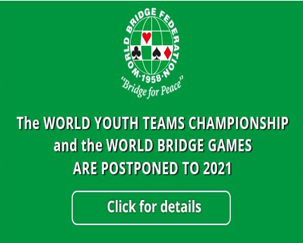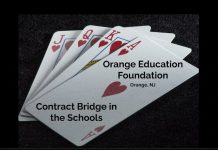When the opponents open a strong NT, the defenders won’t have a game often. Therefore, the primary bidding goal is to disrupt the enemy auction. Natural calls of 2![]() and 2
and 2![]() are not very disruptive, even when they catch a fit, since the opponents have plenty of space to bid the majors they are likely to hold. On the other hand, an auction like 1NT-(2
are not very disruptive, even when they catch a fit, since the opponents have plenty of space to bid the majors they are likely to hold. On the other hand, an auction like 1NT-(2![]() ) -? causes significant difficulties, so we’d like to be able to overcall in 2
) -? causes significant difficulties, so we’d like to be able to overcall in 2![]() /2
/2![]() as frequently as possible. Modern NT overcalling structures give up a natural 2
as frequently as possible. Modern NT overcalling structures give up a natural 2![]() /2
/2![]() in favor of providing more ways to show hands including a major.
in favor of providing more ways to show hands including a major.
My favorite NT defense is the Woolsey defense:
Woolsey
2![]() = both majors
= both majors
2![]() = 1 major (6+)
= 1 major (6+)
2![]() /
/![]() = 5 cards in the major and 4+ in a minor
= 5 cards in the major and 4+ in a minor
dbl = 4-card major and a 5+ card minor
This structure finds all your major suit fits at the cost of occasionally not being able to bid when your suit is a minor. Since most of the time that you hold a long minor you were just going to be outbid in a major suit, losing a minor fit usually costs nothing. In contrast, losing a major fit can be costly. The weakness of the method is the ambiguous 2![]() call to show either major.
call to show either major.
Meckwell
dbl = both majors or one minor
2![]() = clubs and a major
= clubs and a major
2![]() = diamonds and a major
= diamonds and a major
2![]() /
/![]() = 6-card suit
= 6-card suit
The strength of this defense is the immediate natural 2![]() /
/![]() . The weakness are the 2
. The weakness are the 2![]() /
/![]() which leave the more important suit (the major) ambiguous and leave the major/minor length ambiguous.
which leave the more important suit (the major) ambiguous and leave the major/minor length ambiguous.
DONT
dbl = 1 suited, with clubs or diamonds or hearts or spades and strong)
2![]() =
= ![]() and a higher
and a higher
2![]() =
= ![]() and a higher
and a higher
2![]() = majors
= majors
2![]() = 6+ spades
= 6+ spades
Worse than either Meckwell of Woolsey. The 2H call can be 5–4 in either direction which often leads to a guessing game. In both Meckwell and Woolsey you will always get to the better major fit when overcaller holds both majors.
Answer Number 2: Helene Hoegsbro Thygesen
First of all, you have to decide if you want to play double for penalty or not. And whether your primary objective is
- to investigate game and to investigate whether to defend doubled, or
- to compete for the partscore and/or disturb opponent’s auction.
If opps play 1NT as 11–13 or weaker, you certainly want to go for 1. You can easily have a strong balanced hand and you can’t afford to pass, then. Dbl is the only sensible call. This also implies that all bids are limited to about 15/16 points, as you would otherwise have doubled. You probably want to play methods that allow you to get in with all shapy hands that have some major suit length. A sensible method is Apstro:
- 2
 is 4–5 hearts + another; with both majors, hearts will be only 4
is 4–5 hearts + another; with both majors, hearts will be only 4 - 2
 is 4–5 spades + another; with both majors, hearts will be 5
is 4–5 spades + another; with both majors, hearts will be 5
If they play 1NT as 15–17, you certainly go for 2. You are unlikely to have game, and with the occasional balanced 18 count you are quite happy just to pass. DONT, Meckwell, Woolsey, Lionel and Meierson all allow you to enter the auction with a wide variety of hand types by using the double for specific types of unbalanced hands. DONT used to be popular because it is the only method that allows you to bid any 2-suited hand and always stop at the 2-level no matter which suit partner prefers. But DONT doesn’t distinguish between which of the two suits is longer, and most of the time you will start with a dbl or 2cl bid which don’t disturb the opponents at all and which give so little information to partner that he isn’t able to compete. So DONT is not fashionable anymore.
Against 12–14, 13–15 and 14–16, you may go for something in between, i.e. a penalty double but only constructive bids if you hold a 5-card or longer in a major. Multi-Landy then feeds the bill.
If different opponents play different NT ranges, I don’t think it is worthwhile playing different defenses. Just chose something that works well against the average or most common NT range.
Answer Number 3: Kostyantyn Mazur
There are many ways to construct a system of overcalls over a 1NT opener, each with their own features. This answer will go over some of the features.
1) What does the double mean? In particular, is it for penalties?
Over a strong notrump (Kx AQxx JTxx AQx or so), a double should not be for penalties. That hand is too rare, and even some appropriate-looking hands might backfire. For instance, suppose that you hold AQx Kxxx AQxx Kx. That is stronger than most (or all, depending on the range for the opening) strong 1NT openers, but doubling on that hand for penalties is not recommended. What if the double gets passed out? You will be on lead. What do you plan on leading? Anything you lead might blow a trick. Their side might well make 1NT because of the gift. Of course, a priori, you are favored to beat 1NT: you are stronger than your right-hand opponent, and finesses are going to be onside for you. However, declarer now knows this and knows not to finesse into your hand. From time to time, declarer will make 1NT because of the double.
Even if declarer is in trouble over 1NT, responder is in a good position to diagnose this; the other side is given two extra bids, pass and redouble, to run out. They can escape to 2 of a minor, not usually possible if you passed. (2D is a possible contract if Opener responds 2D to Stayman and Responder passes, but even this requires Responder to be prepared for a major-suit response.)
Ax Ax KQJTxx xxx is a reasonably safe penalty double. You would lead the king of diamonds and get seven tricks, plus anything Partner can contribute. Even here, though, some of your advantage goes away because Responder might pull, and you cannot really double anything that they wind up in. You might instead try the effect of passing on this hand to try to defeat 1NT undoubled, as it is likely that they can make two of their suit. Or you can bid your diamonds (however the rest of your system dictates) to try to get a plus score that way. In any case, this hand type is not very frequent.
The point is that you are unlikely to get much out of a penalty double of a strong notrump, while the artificial meanings of the double have more use: getting your side to its best fit.
The weak notrump, though, is a different matter. The penalty double is a lot more useful, because Opener is weaker, leading to potentially larger penalties. Responder might well run from the double (and a weak notrump pair is likely to have discussed their runouts). Then you can bid constructively. The idea is that you need to be able to differentiate strong hands from weaker ones, or else you might miss a game. That risk is small over a strong notrump.
2) Do you have a way to show a two-suited hand?
Over a strong notrump, this makes competing safer. The Law of Total Tricks indicates that you should be safe at the two level. Counting 7 tricks for them playing notrump (as To Bid or Not To Bid advises to), plus 8 for your likely 8-card fit, gives 15 total tricks, so both contracts might make. However, just because you have an 8-card fit somewhere does not mean that you can necessarily find it. That is why you need good methods: to get to that 8-card fit, ideally at the two level. If you find a good fit, Partner might raise you to 3, but you would rather not be forced to play there.
DONT, Meckwell, and the double showing a minor suit and a major suit are all good for this purpose. They all use the double as a means to find the best fit.
Showing minor suits is less important over a weak notrump, over which it is important not to miss games. As is usual in bridge, on any given deal, at most one side is pre-empting; the other side is bidding to make. The weak 1NT opening should be considered as a pre-empt. Since you may have a game, a bid showing both majors is valuable. It could be 2C (Landy), 2D (Cappelletti), or 2H (such as in DONT, but its double is not recommended over a weak 1NT). The lower the bid, the more powerful it is, but the more you give on hands on which you do not use it.
3) How descriptive are your bids?
Over a strong notrump, the more you can tell Partner, the more likely it is that your side will be able to bid on to the three level. Over a weak notrump, the more descriptive your bid is, the more likely it is that Partner will be able to deal with some sort of preemptive jump by Responder.
No matter what, there are not enough bids to safely describe all hands with one bid for each. Some mergers have to be made. Still, the hands described clearly are advantages, while the less well described hands are disadvantages. In that view, DONT works better on the two-suited hands than the one-suited hands. Landy is the other way unless you happen to have both majors (although it depends somewhat on what you would use for your double), as is the double showing a minor and a major. This comes with the territory, though: the double is the cheapest action, and so it needs to cover a lot of ground.
Traditionally the double of a 1NT opening bid was for penalty. In the “old” days it showed an equivalent to a strong NT, but people learned that you needed a source of tricks to beat 1NT.
If the opponents are playing a weak NT, you are almost forced to play a double as showing values, you are already in a swing situation so you need to make sure you try to recover equity.
In modern style, DONT and Meckwell (as well as Brozel, a convention out of favor) double show a one suited hand leaving other bids to describe two suiters. Meckwell keeps 2H and 2S as natural so the double shows a single MINOR suit or BOTH majors (which was covered in DONT with 2 Hearts.
Landy is an older convention – 2 clubs shows both majors, everything else is natural. There is also “modified” Landy where 2 Clubs shows minors and 2 Diamonds shows majors.
There are MANY other NT conventions including Woolsey, Suction, ASTRO and others. It probably doesn’t make a huge difference in the long run which one you play but make sure you and partner are on the same wavelength for the various actions –
- Do we play differently over week NT than strong?
- Do we play differently in balancing seat?
- What are minimums for strength and distribution?
- What are the follow-ups. Especially – what are the followups to a penalty or values double. What is forcing? What is weak?
The game doesn’t hinge on how many conventions you can fit on your card, it does swing on how many misunderstandings you have with your partner!
Don’t forget to follow us @


























